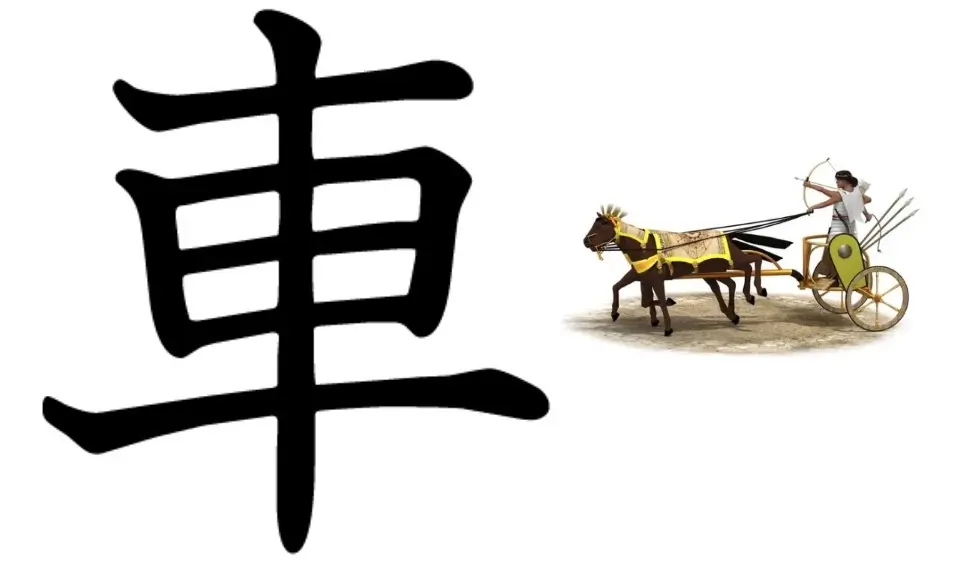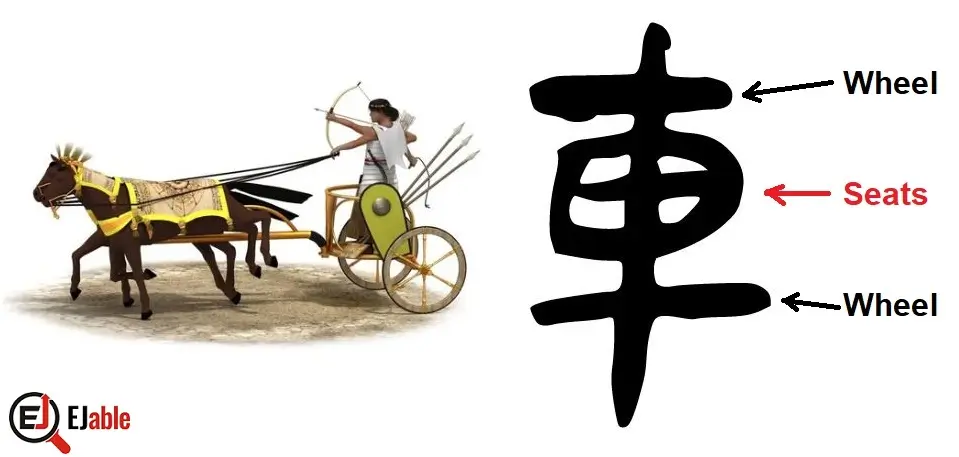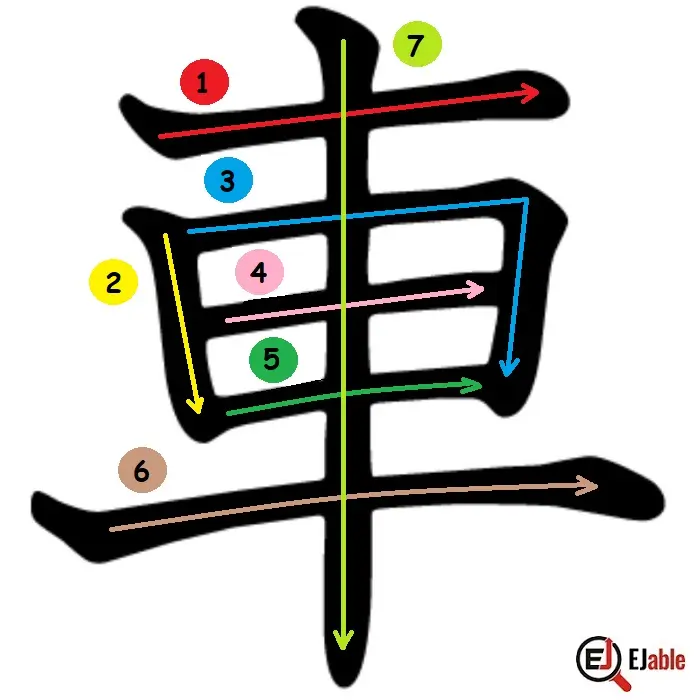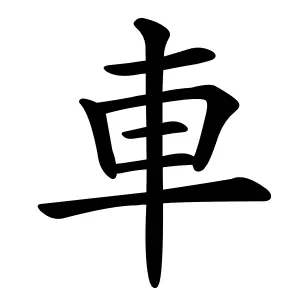Kanji for Car or Vehicle: 車 (Kuruma or Sha)

The Japanese Kanji for the “car” or “vehicle” is 車. As a standalone Kanji, it is pronounced as “Kuruma” but when it appears in combination with other Kanji, the pronunciation is “Sha” – for example, Densha (電車), meaning Train or Jitensha (自転車), meaning Bicycle.
The Kanji 車 is constructed with 7 strokes. This Kanji is a part of the JLPT N5 syllabus (please check the list of JLPT N5 Kanji). In Japanese schools, this Kanji is taught in grade 1.
Origin and How to Remember Car’s Kanji 車
Looking at the original form of the character, you can see it’s a pictogram of a chariot viewed from the top (top view). The character shows two wheels (the squares on either side) and the body of the chariot in the middle.


The character has simplified and evolved over time. It moved from the complex pictographic form seen in oracle bone script and bronze inscriptions to the more stylized and simplified form seen in seal script and then to the more abstract form used today in modern Chinese and Japanese.
Stroke Order for the Kanji 車
The following illustrations show the stroke order to write the Kanji 車, meaning car or a vehicle (kuruma):




車: Related Kanji Characters and Pronunciation
In modern usage, the character “車” alone can mean “car”, “vehicle”, or “wheel” in Japanese. It is also used as a Kanji radical in other characters, such as 軍 (“gun”, meaning army), 輪 (“rin,” meaning wheel or ring), or 転 (“ten”, to revolve, to turn). These characters all have something to do with the concept of movement or transportation, carrying forward the original meaning of the pictogram.
In terms of pronunciation, in the on’yomi (Chinese reading) it is read as “sha”, and in the kun’yomi (Japanese reading) it is read as “kuruma”.
Car’s Kanji as Radical and Component
The Kanji of Car or Vehicle is also among the most commonly used Kanji radicals.
Overall, Kanji 車 appears as a radical or as a component in 206 Kanji characters, including 27 Jōyō Kanji.
Examples of 車 as a radical
Following are some examples of kanji where 車 appears as a radical:
- 軍 (gun) – army, force, troops
- 転 (ten) – revolve, turn around, change
- 軸 (jiku) – axis, pivot, stem, stalk, center
- 軟 (nan) – soft
- 軽 (kei) – light (in weight), minor, trivial
- 軫 (chin) – the crossbar in the back of a carriage to hang things on (less common in daily usage)
- 軺 (you) – small wagon, handcart (less common in daily usage)
- 較 (kaku) – contrast, compare
- 輪 (rin) – wheel, ring, circle
- 輸 (yu) – transport, send, be inferior
- 輝 (ki) – radiance, shine, sparkle
- 輩 (hai) – comrade, fellow
- 轄 (katsu) – control, wedge
- 轟 (gou) – roar, thunder, boom, rumble
- 轢 (rekki) – run over
Please note that while all these kanji use 車 as a radical, their meanings can vary greatly, and not all are directly related to the concept of a vehicle or movement.
Kanji 車’s Use in Language
The kanji for “car” or “vehicle,” 車 (くるま, kuruma), is commonly used in the Japanese language and forms part of many compound words. There are 101 Japanese words that begin with the Kanji 車, and it appears in 581 words.
Examples of Kanji 車 in Compounded Kanji Characters
Following are the examples where Kanji for car or vehicle appears in Japanese compounded Kanji characters:
- 自転車 (じてんしゃ, jitensha): Bicycle.
- 自動車 (じどうしゃ, jidōsha): Automobile, car.
- 車輪 (しゃりん, sharin): Wheel.
- 鉄道車両 (てつどうしゃりょう, tetsudō sharyō): Railway vehicle, train car.
- 車両 (しゃりょう, sharyō): Vehicle, railway car.
- 車内 (しゃない, shanai): Inside the car.
- 車線 (しゃせん, shasen): Traffic Lane.
- 車窓 (しゃそう, shasō): Car window.
- 電車 (でんしゃ, densha): Electric train.
- 手荷物車 (てにもつぐるま, tenimotsuguruma): Luggage cart.
- 乗用車 (じょうようしゃ, jōyōsha): Passenger car.
- 貨物車 (かもつしゃ, kamotsha): Freight car, cargo car.
- 車掌 (しゃしょう, shashō): Train conductor.
- 車庫 (しゃこ, shako): Garage, car shed.
- 車椅子 (くるまいす, kurumaisu): Wheelchair.
- 車道 (しゃどう, shadō): Roadway, car lane.
These examples demonstrate the broad usage of the Kanji for car ‘車’ in the Japanese language, extending from literal references to various types of vehicles to parts and related concepts of automobiles and trains.
Do check other Kanji characters on the page “How to Remember Kanji“.


A long-term ex-pat in Japan, Himanshu comes with an IT background in SAP consulting, IT Business Development, and then running the country operations of an IT consulting multinational. Himanshu is the co-founder and Managing Director of ReachExt K.K. and EJable.com. He is also an Advisory Board Member of a Silicon Valley AI/IoT startup.

